Radar-Only Cooperative Adaptive Cruise Control Under Acceleration Disturbances: ACC, KF-CACC, and Multi-Q IMM-KF CACC
Abstract
1. Introduction
- A unified modeling and evaluation framework for ACC, KF-CACC, and Multi-Q IMM-KF-CACC under a constant time gap (CTG) policy.
- A detailed design methodology for the Multi-Q IMM-KF estimator, leveraging multi-model blending to accommodate diverse driving dynamics [24].
2. System Modeling
2.1. Longitudinal Vehicle Dynamics
2.2. Discretization
2.3. Constant Time-Gap (CTG) Spacing Policy
2.4. Adaptive Cruise Control (ACC) Dynamics
2.5. Cooperative Adaptive Cruise Control (CACC)
3. Kalman Filter Design
3.1. Requirement for Kalman Filtering in Radar-Only CACC
3.2. Nominal KF-Based Estimation
3.3. Multi-Q IMM-KF-Based Estimation
3.3.1. Modeling Philosophy
- Low-jerk (LJ) mode: This mode employs a small process noise covariance for steady cruising.
- High-jerk (HJ) mode: This mode uses a large covariance for rapid responsiveness during aggressive maneuvers.
3.3.2. Step 1: Mixing
3.3.3. Step 2: Mode-Matched Filtering
3.3.4. Step 3: Mode Probability Update
3.3.5. Step 4: Estimate Fusion
4. String Stability Analysis
5. Simulation Setup and Results
5.1. ACC vs. Nominal KF vs. Multi-Q IMM-KF
5.2. IMM Mode Probabilities
6. Experimental Validation Using Real Vehicle Data
6.1. Experimental Setup
6.2. Comparative Results and Discussion
6.3. IMM Mode Probability Analysis
7. Conclusions
Author Contributions
Funding
Institutional Review Board Statement
Informed Consent Statement
Data Availability Statement
Conflicts of Interest
References
- Moon, S.; Yi, K. Human-driving-data-based design of a vehicle adaptive cruise control algorithm. Veh. Syst. Dyn. 2008, 46, 661–690. [Google Scholar] [CrossRef]
- Xiao, L.; Gao, F. A comprehensive review of the development of adaptive cruise control systems. Veh. Syst. Dyn. 2010, 48, 1167–1192. [Google Scholar] [CrossRef]
- Vahidi, A.; Eskandarian, A. Research advances in intelligent collision avoidance and adaptive cruise control. IEEE Trans. Intell. Transp. Syst. 2003, 4, 143–153. [Google Scholar] [CrossRef]
- Shladover, S.E.; Desoer, C.A.; Hedrick, J.K.; Tomizuka, M.; Walrand, J.; Zhang, W.-B.; McMahon, D.H.; Peng, H.; Sheikholeslam, S.; McKeown, N. Automated vehicle control developments in the PATH program. IEEE Trans. Veh. Technol. 1991, 40, 114–130. [Google Scholar] [CrossRef]
- Hedrick, J.; McMahon, D.; Narendran, V.; Swaroop, D. Longitudinal vehicle controller design for IVHS systems. In Proceedings of the American Control Conference, Boston, MA, USA, 26–28 June 1991; pp. 3107–3112. [Google Scholar]
- Rajamani, R. Vehicle Dynamics and Control, 2nd ed.; Springer: Berlin/Heidelberg, Germany, 2011. [Google Scholar]
- Wang, J.; Rajamani, R. Adaptive cruise control system design and its impact on highway traffic flow. In Proceedings of the American Control Conference, Anchorage, AK, USA, 8–10 May 2002; Volume 5, pp. 3690–3695. [Google Scholar]
- Naus, G.J.L.; Vugts, R.P.A.; Ploeg, J.; van de Molengraft, M.J.G.; Steinbuch, M. String-stable CACC design and experimental validation: A frequency-domain approach. IEEE Trans. Veh. Technol. 2010, 59, 4268–4279. [Google Scholar] [CrossRef]
- Liang, C.Y.; Peng, H. Adaptive cruise control with guaranteed string stability. Veh. Syst. Dyn. 1999, 32, 313–330. [Google Scholar] [CrossRef]
- Swaroop, D.; Hedrick, J.K.; Choi, S.B. Direct adaptive longitudinal control of vehicle platoons. IEEE Trans. Veh. Technol. 2001, 50, 150–161. [Google Scholar] [CrossRef]
- Feng, S.; Zhang, Y.; Li, S.E.; Cao, Z.; Liu, H.X.; Li, L. String stability for vehicular platoon control: Definitions and analysis methods. Annu. Rev. Control 2019, 47, 81–97. [Google Scholar] [CrossRef]
- Sheikholeslam, S.; Desoer, C.A. Longitudinal control of a platoon of vehicles with no communication of lead vehicle information: A system level study. IEEE Trans. Veh. Technol. 1993, 42, 546–554. [Google Scholar] [CrossRef]
- Dey, K.C.; Yan, L.; Wang, X.; Wang, Y.; Shen, H.; Chowdhury, M.; Yu, L.; Qiu, C.; Soundararaj, V. A review of communication, driver characteristics, and control aspects of cooperative adaptive cruise control (CACC). IEEE Trans. Intell. Transp. Syst. 2016, 17, 491–509. [Google Scholar] [CrossRef]
- Öncü, S.; Ploeg, J.; van de Wouw, N.; Nijmeijer, H. Cooperative adaptive cruise control: Network-aware analysis of string stability. IEEE Trans. Intell. Transp. Syst. 2014, 15, 1527–1537. [Google Scholar] [CrossRef]
- Ploeg, J.; Scheepers, B.T.M.; van Nunen, E.; van de Wouw, N.; Nijmeijer, H. Design and experimental evaluation of cooperative adaptive cruise control. In Proceedings of the IEEE International Conference on Intelligent Transportation Systems (ITSC), Washington, DC, USA, 5–7 October 2011; pp. 260–265. [Google Scholar]
- Choi, S.B.; Hedrick, J.K. Vehicle longitudinal control using an adaptive observer for automated highway systems. In Proceedings of the American Control Conference, Seattle, WA, USA, 21–23 June 1995; Volume 5, pp. 3106–3110. [Google Scholar]
- Rajamani, R.; Choi, S.B.; Law, B.K.; Hedrick, J.K.; Prohaska, R.; Kretz, P. Design and experimental implementation of longitudinal control for a platoon of automated vehicles. J. Dyn. Syst. Meas. Control 2000, 122, 470–476. [Google Scholar] [CrossRef]
- Bozzi, A.; Zero, E.; Sacile, R.; Bersani, C. Real-time robust trajectory control for vehicle platoons: A linear matrix inequality-based approach. In Proceedings of the 18th International Conference on Informatics in Control, Automation and Robotics (ICINCO), Paris, France, 6–8 July 2021; pp. 410–415. [Google Scholar]
- Di Bernardo, M.; Salvi, A.; Santini, S. Distributed consensus strategy for platooning of vehicles in the presence of time-varying heterogeneous communication delays. IEEE Trans. Intell. Transp. Syst. 2015, 16, 1026–1032. [Google Scholar] [CrossRef]
- Massera Filho, C.; Terra, M.H.; Wolf, D.F. Safe optimization of highway traffic with robust model predictive control-based cooperative adaptive cruise control. IEEE Trans. Intell. Transp. Syst. 2017, 18, 3193–3203. [Google Scholar] [CrossRef]
- Hult, R.; Zanon, M.; Gros, S.; Falcone, P. Optimal coordination of automated vehicles at intersections: Theory and experiments. IEEE Trans. Control Syst. Technol. 2018, 27, 2510–2525. [Google Scholar] [CrossRef]
- Jin, I.G.; Orosz, G. Dynamics of connected vehicle systems with delayed acceleration feedback. Transp. Res. Part C Emerg. Technol. 2014, 46, 46–64. [Google Scholar]
- Harfouch, Y.A.; Yuan, S.; Baldi, S. An adaptive switched control approach to heterogeneous platooning with inter-vehicle communication losses. IEEE Trans. Control Netw. Syst. 2017, 5, 1434–1444. [Google Scholar] [CrossRef]
- Franklin, G.F.; Powell, J.D.; Workman, M.L. Digital Control of Dynamic Systems, 3rd ed.; Addison-Wesley: Menlo Park, CA, USA, 1998. [Google Scholar]
- Batkovic, I.; Zanon, M.; Ali, M.; Falcone, P. Real-time constrained trajectory planning and vehicle control for proactive autonomous driving with road users. In Proceedings of the 18th European Control Conference (ECC), Naples, Italy, 25–28 June 2019; pp. 256–262. [Google Scholar]
- Li, S.; Yang, J.; Chen, W.H.; Chen, X. Generalized extended state observer based control for systems with mismatched uncertainties. IEEE Trans. Ind. Electron. 2012, 59, 4792–4802. [Google Scholar] [CrossRef]
- Kang, C.M. Disturbance observer-based robust cooperative adaptive cruise control approach under heterogeneous vehicles. IEEE Trans. Intell. Transp. Syst. 2020, 21, 1637–1647. [Google Scholar] [CrossRef]
- Ploeg, J.; Nijmeijer, H. Spacing Policies for Adaptive Cruise Control: A Survey. IEEE Access 2020, 8, 50149–50162. [Google Scholar] [CrossRef]
- Dai, Y.; Yang, Y.; Zhong, H.; Zuo, H.; Zhang, Q. Stability and safety of cooperative adaptive cruise control vehicular platoons under diverse information flow topologies. J. Adv. Transp. 2022, 2022, 4534692. [Google Scholar] [CrossRef]
- Lee, K.; Lee, C. PD control with feedforward compensation for string-stable cooperative adaptive cruise control in vehicle platoons. Sensors 2025, 25, 5434. [Google Scholar] [CrossRef] [PubMed]
- Dong, H.; Shi, J.; Zhuang, W.; Li, Z.; Song, Z. Analyzing the impact of mixed vehicle platoon formations on vehicle energy and traffic efficiencies. Appl. Energy 2024, 348, 124448. [Google Scholar] [CrossRef]



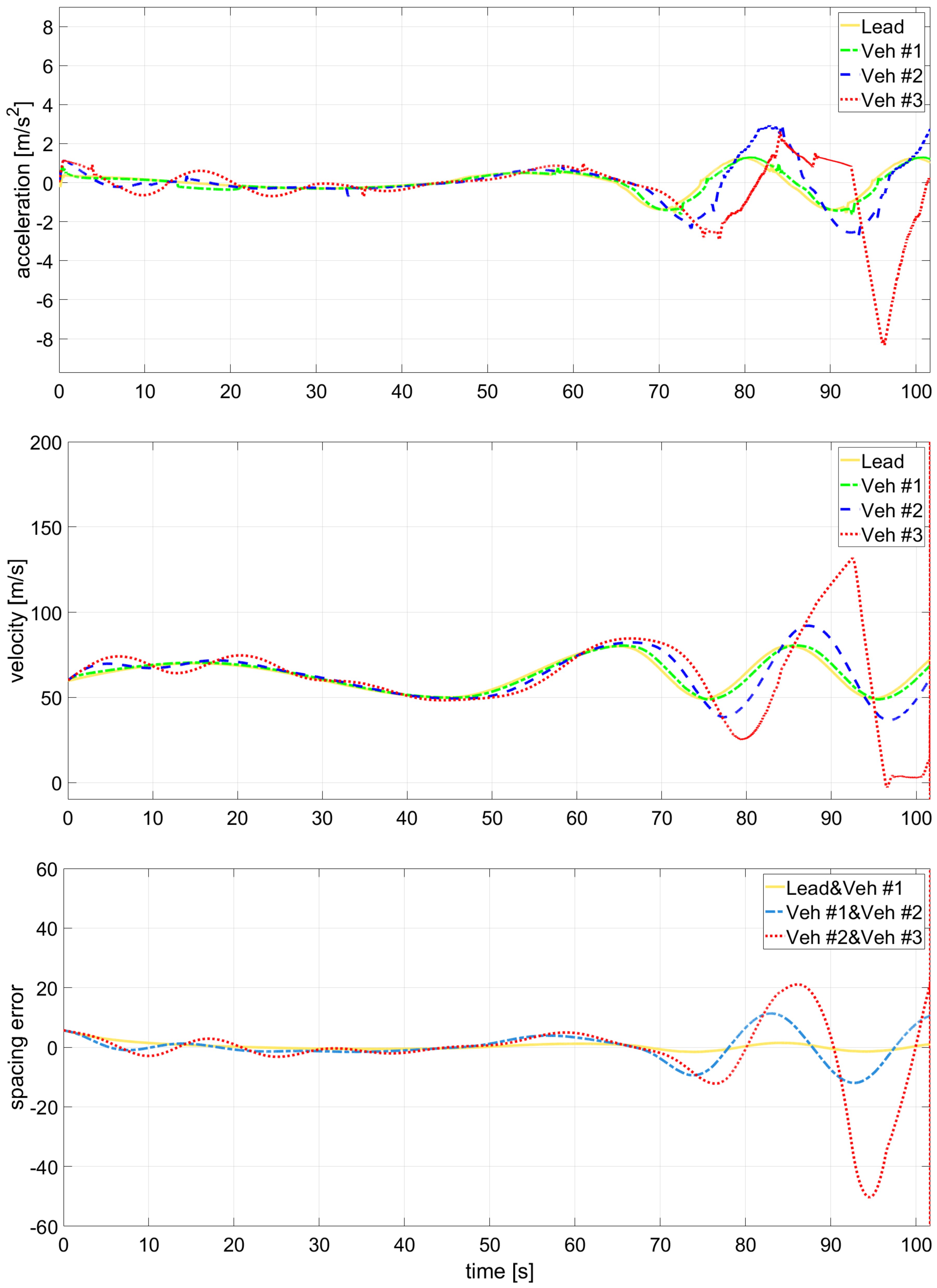
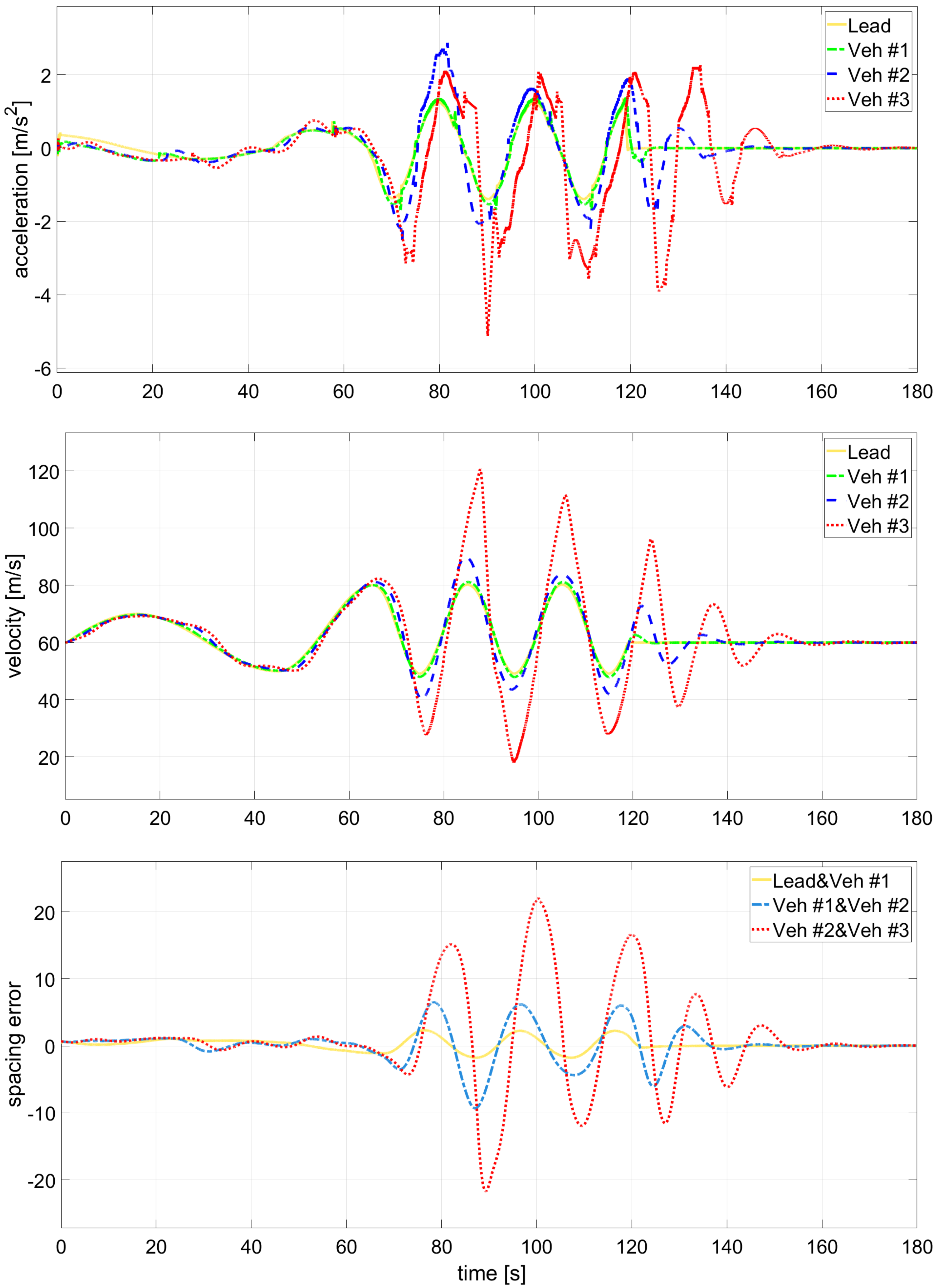


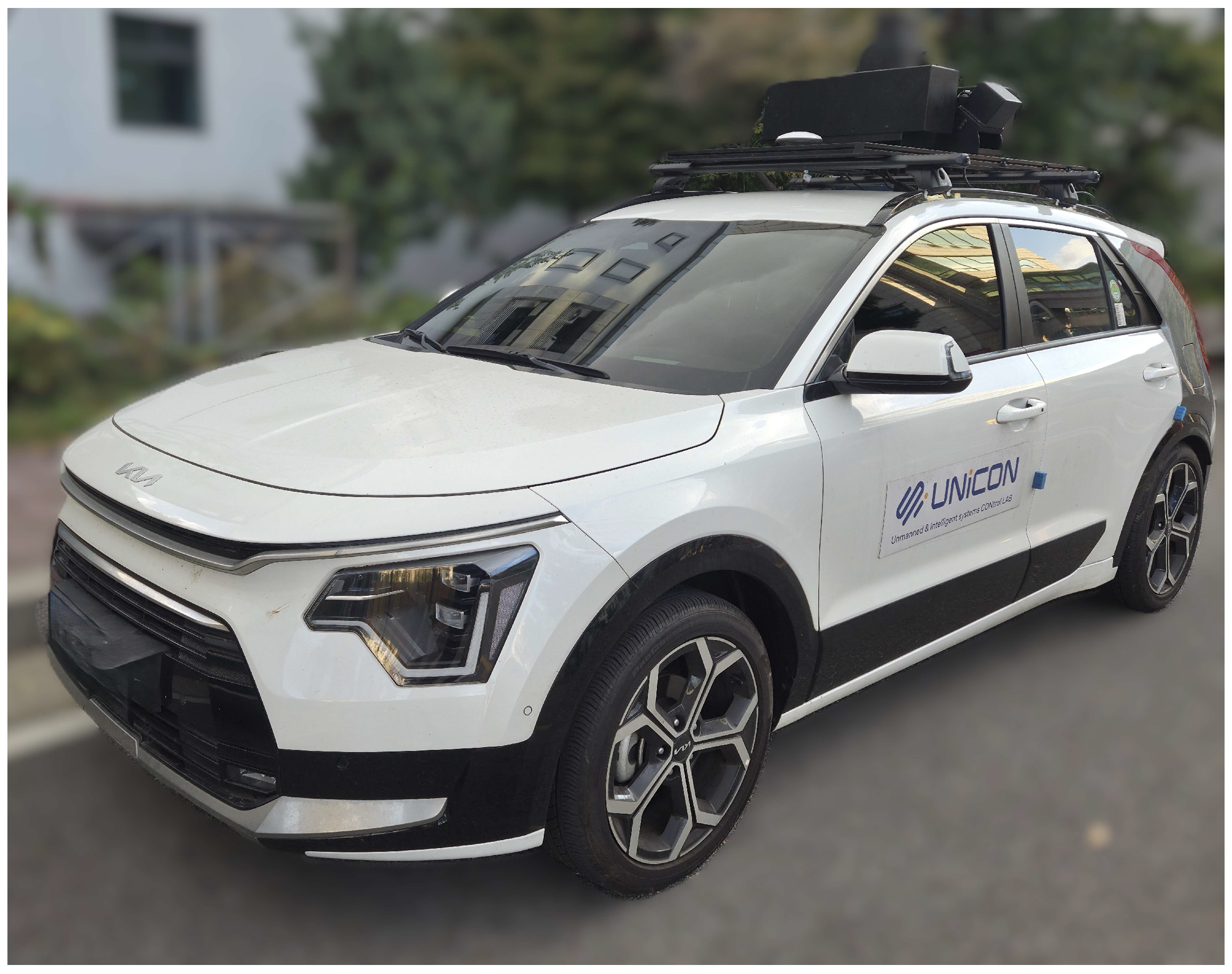

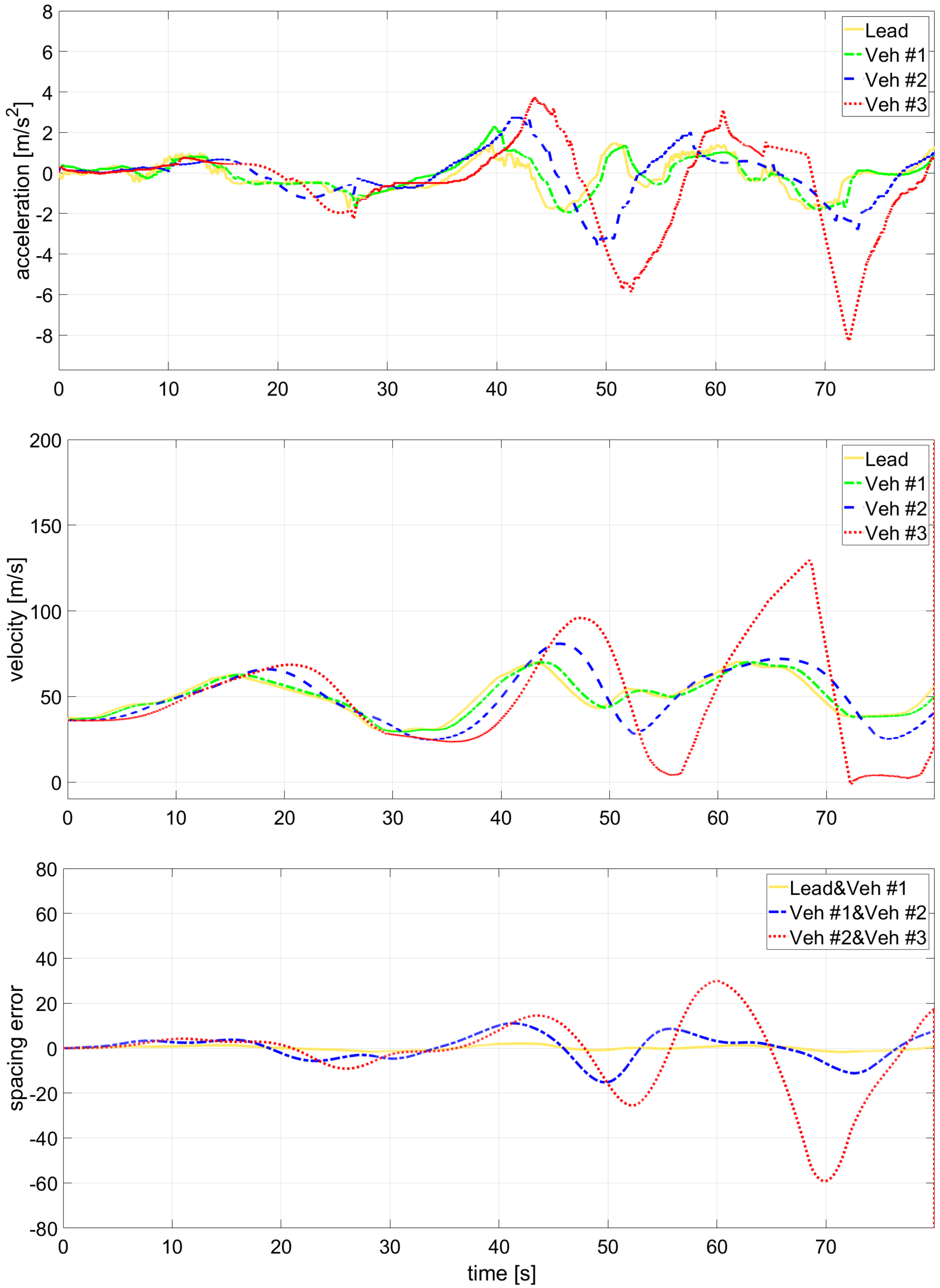
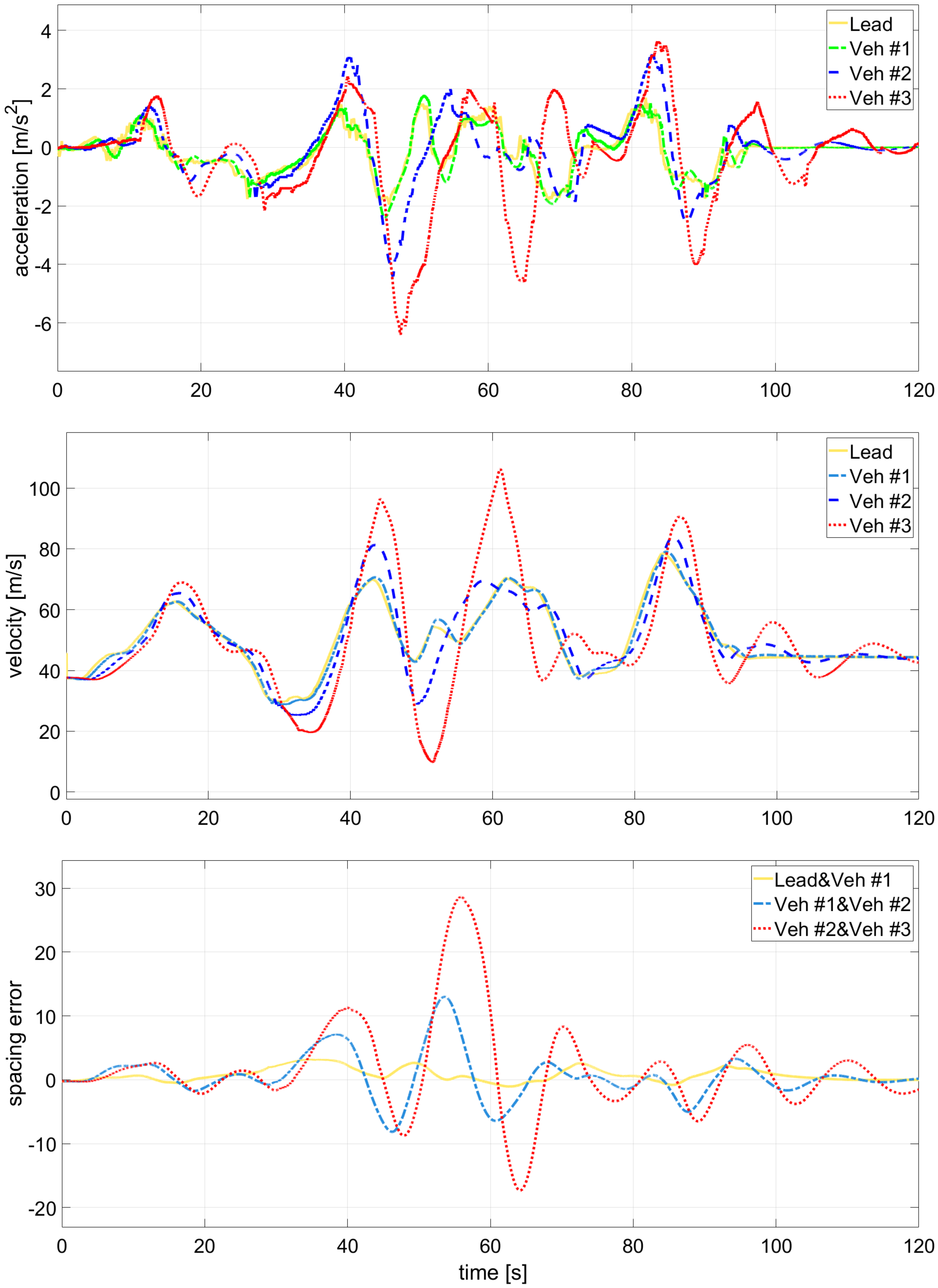
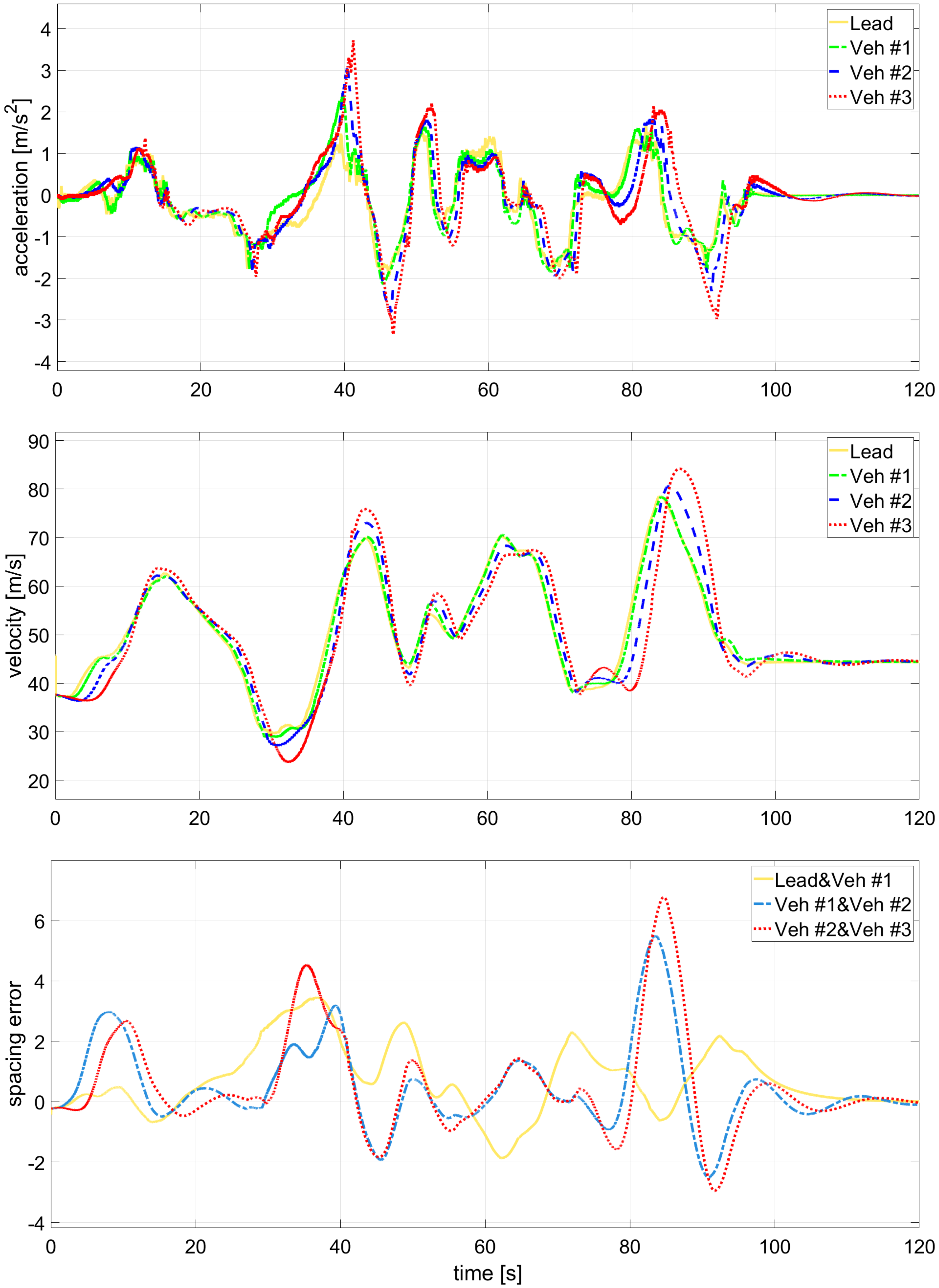

| Vehicle | Nominal KF CACC (m/s) | Multi-Q IMM-KF CACC (m/s) |
|---|---|---|
| Follower 1 (2nd vehicle) | 0.3227 | 0.3067 |
| Follower 2 (3rd vehicle) | 1.5124 | 1.2366 |
| Follower 3 (4th vehicle) | 3.4208 | 2.2766 |
| Vehicle | Nominal KF CACC (m/s) | Multi-Q IMM-KF CACC (m/s) |
|---|---|---|
| Follower 1 (2nd vehicle) | 0.3525 | 0.3163 |
| Follower 2 (3rd vehicle) | 1.6131 | 1.2569 |
| Follower 3 (4th vehicle) | 3.9178 | 2.4732 |
Disclaimer/Publisher’s Note: The statements, opinions and data contained in all publications are solely those of the individual author(s) and contributor(s) and not of MDPI and/or the editor(s). MDPI and/or the editor(s) disclaim responsibility for any injury to people or property resulting from any ideas, methods, instructions or products referred to in the content. |
© 2025 by the authors. Licensee MDPI, Basel, Switzerland. This article is an open access article distributed under the terms and conditions of the Creative Commons Attribution (CC BY) license (https://creativecommons.org/licenses/by/4.0/).
Share and Cite
Lim, J.; Kim, G.; Jeong, C.; Kang, C. Radar-Only Cooperative Adaptive Cruise Control Under Acceleration Disturbances: ACC, KF-CACC, and Multi-Q IMM-KF CACC. Appl. Sci. 2025, 15, 12199. https://doi.org/10.3390/app152212199
Lim J, Kim G, Jeong C, Kang C. Radar-Only Cooperative Adaptive Cruise Control Under Acceleration Disturbances: ACC, KF-CACC, and Multi-Q IMM-KF CACC. Applied Sciences. 2025; 15(22):12199. https://doi.org/10.3390/app152212199
Chicago/Turabian StyleLim, Jihun, Guntae Kim, Cheolmin Jeong, and Changmook Kang. 2025. "Radar-Only Cooperative Adaptive Cruise Control Under Acceleration Disturbances: ACC, KF-CACC, and Multi-Q IMM-KF CACC" Applied Sciences 15, no. 22: 12199. https://doi.org/10.3390/app152212199
APA StyleLim, J., Kim, G., Jeong, C., & Kang, C. (2025). Radar-Only Cooperative Adaptive Cruise Control Under Acceleration Disturbances: ACC, KF-CACC, and Multi-Q IMM-KF CACC. Applied Sciences, 15(22), 12199. https://doi.org/10.3390/app152212199






